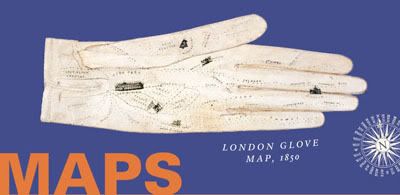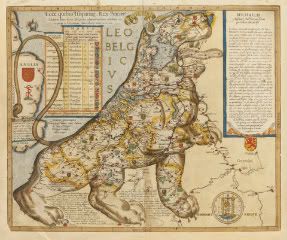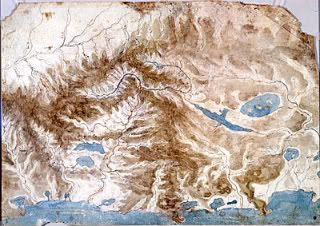Walking into the Walters newest exhibit, I had one expectation: it would be a boring tribute to the Rand McNallys of the world. However, I was pleasantly surprised and intrigued by the vast array of types, formats, and displays of maps. Not only were there maps in paper, they came in the form of clay tablets, engraved stones, ceramics, wood and beads, rubbings of engravings, canvas, manuscript, a board game, embroidery, computer generation, and even a lady’s glove.
The media used on these maps were just as variable as the maps themselves. Ink, oil paint, chalk, pigment, thread, and engraving marks were just some of the media cartographers have used. What was more interesting, however, were the kinds of maps. The exhibit was broken down into eight sections, each displaying a different subject matter.
The first section was “Way Finding Maps”. These maps answered three questions: 1) Where am I? 2) Where do I want to go? 3) How do I get there? The second section was “Mapping Imaginary Worlds”. J.R.R. Tolkien’s maps from his legendary books were on display, along with “The Land of Make Believe”. The next part was “Mapping Your World: Your Own Neighborhood”. This was an insight into how people perceived their location within their own community. Here, there were maps on clay tablets, ceramics, and more 3-D materials. The fourth section furthered the last: “Mapping Your World: Claiming Your Territory”. These maps were of foreign territories (foreign to the cartographer, that is). These maps described places for people who were unfamiliar with them. This section was “outward looking, showing encounters between disparate cultures”.
The next section was “Mapping Your World: Cities”. These maps were much more intricate as they had more detail than the others. A map of the view of Amsterdam was oil painted on canvas with extremely detailed buildings, ships, and canals. The sixth part was “Mapping Nature and Society”. Here were Leonardo Da Vinci’s drawings of Italian cities, ethnographic maps that broke up linguistic groups in the Balkan Peninsula by color, wage and ethnicity maps of Chicago, and maps of illiteracy rates in London.
The most interesting map in the seventh section of “Mapping History: Making America” was a computer generation of the Civil War in four minutes. It showed the constantly changing borders between the Confederacy and the North as a ticker on the bottom left counted through the days and number of casualties. The last section of the exhibit was “Living with Maps”. The most interesting piece here was the map of Germana Inferior that was replicated on the wall in “Young Woman with a Water Jug” by Vermeer. The more unusual maps were in this section: the board game Risk, embroidered maps, and a map drawn on a glove.
For the time period in which each of these maps were created, they proved useful. Maps, in essence, are to be useful and effective in orienting yourself and help you find where you’re going. In modern day (and as far as geography is concerned), some of these maps would look very different from when they were first made, while some would be pretty accurate. However, the world is constantly changing, both physically and socially. Maps will change too then. The exhibit is therefore effective in showing how cartographers have adapted to that change throughout history.
The one bone I have to pick with this exhibit is a fairly big one. The descriptions for each piece were often placed down in the case so that if there were 2 or more people looking at the same piece it became very hard to read. The dim lighting, as necessary as it was to maintain the integrity of the pieces, did not help in reading these badly placed descriptions. The sometimes cramped space did not help either. Overall though, the progression of the exhibit made it easy to find my way through and allowed me to appreciate the pieces more thoroughly by grouping them by theme.
As an artist, I really appreciated the spatial intelligence of the cartographers and their ability to stay true to scale. I gained a new appreciation for patience and attention to detail. What I found the most intriguing, though, was the variety in which maps were perceived and created. A lesson I can take out of this exhibit is to think outside of my box, however unconventional or impractical it may be. One thing or idea could have dozens of different contexts, made with different media on different materials, in 2D or 3D. Finding my way through the “Maps” exhibit was fairly easy, though finding my way through my own art I feel will be a struggling journey. Hopefully the open mind I feel after having just seen this exhibit will remain along the way and help me if I become too narrow-minded in my artistic pursuits. All I know is Rand McNally will never have the same meaning to me again.
– Mai Luong








